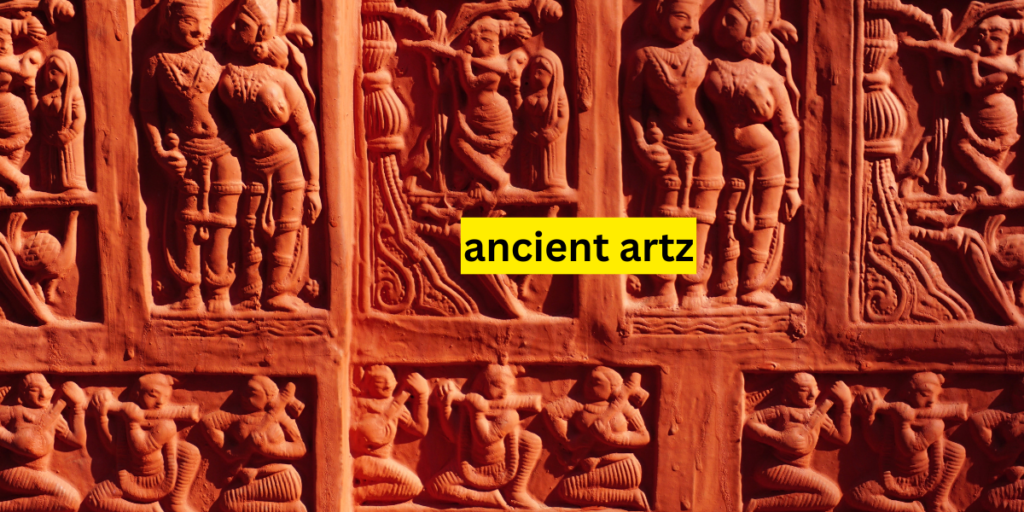Step into a time machine crafted from clay, stone, and pigment as we embark on an enchanting journey through the corridors of history! The whispers of ancient civilizations echo in their art—each brushstroke, sculpture, and mosaic tells a story that transcends time. From the intricate hieroglyphs of Egypt to the vibrant frescoes of Mesoamerica, these masterpieces are more than mere decorations; they are windows into the soul of humanity’s past. Join us as we unravel how ancient art serves not only as a visual feast but also as a profound reflection of beliefs, values, and dreams long forgotten. Prepare to be captivated by tales etched in time—where every artifact holds secrets waiting to be uncovered!
Introduction to Ancient Artz and its Significance
Ancient artz serves as a time capsule, transporting us back to civilizations that flourished long before our own. Each brushstroke and chisel mark tells a story, revealing the beliefs, values, and daily lives of those who walked the earth centuries ago. With every artifact unearthed and mural examined, we unlock secrets about human existence that have shaped cultures across the globe. As we delve into this fascinating world of ancient artistry, we not only connect with our past but also gain insights into what it means to be human. Join us on this journey through history where art becomes more than mere decoration; it is a powerful narrative waiting to be uncovered.
The Role of Art in Ancient Civilizations
Art served as a powerful medium in ancient civilizations, transcending mere decoration. It was intertwined with daily life, religion, and governance. From monumental sculptures to intricate pottery, every piece told a story.
In Egypt, for example, art celebrated the divine and immortalized pharaohs. Hieroglyphics on tomb walls conveyed beliefs about the afterlife and spiritual journeys.
Greek art focused on humanism and beauty. Statues of gods were crafted with precision to reflect ideal forms and virtues cherished by society.
Mayan artistry showcased vibrant murals that depicted rituals and cosmology. These visual narratives linked their people to deities while documenting historical events.
Across cultures, art became an enduring voice of identity. It provided insights into societal norms, values, and aspirations—illuminating how ancient civilizations viewed themselves and their place in the universe.
How Ancient Art Reflects Beliefs and Values
Ancient artz serves as a powerful lens into the soul of bygone civilizations. Each brushstroke, carving, or sculpture tells stories about what mattered most to those who created it.
Religious themes often dominate ancient artworks. Deities and rituals are depicted with reverence, reflecting society’s spiritual values and beliefs. These representations offer insight into how people understood their world and sought connection with the divine.
Social hierarchies also emerge in these artistic expressions. Artisans highlighted status through grand portraits of rulers or heroic figures. This focus illustrates the importance placed on power dynamics within their communities.
Furthermore, daily life is captured in intricate details—clothing styles, agricultural practices, and leisure activities reveal cultural priorities. Through ancient artz, we gain not just aesthetic appreciation but deep understanding of human experience across time.
Examples of Ancient Art from Different Civilizations (Egyptian, Greek, Mayan, etc.)
Ancient artz offers a glimpse into the soul of different civilizations. The Egyptians, for instance, created stunning hieroglyphs and intricate tomb paintings that celebrated their gods and pharaohs. Each symbol carried profound meaning, reflecting their beliefs about the afterlife.
In Ancient Greece, pottery was transformed into storytelling canvases. Vivid scenes of mythology adorned amphorae, revealing tales of heroism and adventure. These artworks not only served practical purposes but also communicated cultural values.
Mayan civilization showcased remarkable stone carvings and murals in their temples. Their art often depicted rituals and celestial events, emphasizing a deep connection to nature and spirituality.
Through these examples, we see how ancient artz transcends mere aesthetics. It encapsulates the essence of each culture’s identity while preserving their stories for generations to come.
Deciphering Symbols and Hidden Messages in Ancient Art
Ancient artz is a treasure trove of symbols and hidden messages. Each brushstroke, carving, or clay mold often tells more than meets the eye. Artists from various civilizations infused their work with meaning that transcended time.
Take Egyptian hieroglyphs, for instance. These intricate symbols convey complex ideas about the afterlife and divine order. They were not mere decorations; they served as a language to communicate profound beliefs.
In contrast, Mayan art features geometric patterns and motifs representing nature’s cycles. Those designs reflect their understanding of astronomy and agriculture—elements essential to survival.
The Greeks employed symbolism too. Their sculptures captured ideals like beauty and heroism through meticulously crafted forms.
Decoding these elements can reveal much about cultural values, societal structures, and even daily life in ancient times. The richness of these narratives makes ancient artifacts endlessly fascinating to explore.
Uncovering Daily Life through Artifacts and Depictions in Art
Artifacts serve as windows into the daily lives of ancient people. Each piece tells a story, revealing how they ate, worked, and celebrated.
Consider pottery adorned with intricate designs. These vessels were more than functional; they reflect social status and artistic expression. The style and materials used can indicate trade routes or regional influences.
Sculptures often depict scenes from everyday life, showcasing clothing styles, tools, and family dynamics. They provide context about societal structures and gender roles within a civilization.
Wall paintings in tombs bring to life rituals surrounding death and the afterlife. Such art captures not just beliefs but also mundane activities like farming or feasting that were significant to their existence.
These glimpses into past lifestyles enrich our understanding of human behavior across time periods. By studying these artifacts, we can connect with those who walked the earth long before us.
The Evolution of Ancient Art over Time and Across Cultures
Ancient artz serves as a fascinating mirror reflecting the evolution of human culture. Each civilization, from Mesopotamia to Mesoamerica, left its unique imprint through distinct styles and materials.
As societies grew more complex, their art transformed. Early cave paintings focused on survival themes—hunting scenes and animal representations. Later civilizations embraced intricate narratives that included mythology and daily life.
The medium also evolved dramatically. Ancient Egyptians utilized stone carvings while Greeks explored marble sculptures with astonishing realism. In contrast, Mayan artists specialized in vibrant murals that celebrated cosmic events.
Cross-cultural influences began emerging as trade routes expanded. Techniques were shared, leading to hybrid forms of art that showcased diverse beliefs and practices.
This constant change not only reflects advancements in technique but also tells us about shifting societal values over centuries—the eternal quest for meaning captured on canvas or carved into stone remains timeless.
Modern Day Understanding and Appreciation of Ancient Artz
Today, ancient artz captivates audiences worldwide. Museums and galleries showcase these masterpieces, inviting viewers to connect with the past.
Digital technology enhances accessibility. Virtual tours allow people from all corners of the globe to explore artifacts without leaving home. Social media platforms spark discussions about ancient cultures, broadening interest in their visual narratives.
Art historians and archaeologists work together to unravel mysteries behind each piece. They analyze techniques and materials used by artisans centuries ago, revealing insights into daily life and belief systems.
Moreover, contemporary artists draw inspiration from ancient artz. They incorporate traditional motifs into modern works, creating a dialogue between eras that resonates with today’s society.
Education programs promote understanding among younger generations. Workshops encourage creativity while exploring themes found in historical pieces. This engagement fosters appreciation for diverse cultural heritages around the world, ensuring that ancient art continues to inspire future minds.
Conclusion: Why Studying Ancient Art is Important for Our Understanding of History
Studying ancient artz is essential for grasping the complexities of human history. Each piece serves as a window into the thoughts, beliefs, and experiences of civilizations that have long since vanished. By analyzing these artifacts, we gain insight into how societies functioned, what they valued, and how they expressed their identity.
Ancient art allows us to connect emotionally with people from different eras. It transcends time and language barriers, offering glimpses of shared human experience. The depictions in ancient carvings or paintings tell stories that resonate even today—stories about love, spirituality, power struggles, and everyday life.
Furthermore, understanding ancient art helps preserve cultural heritage. As we study it critically and appreciatively, we foster respect for diversity among cultures throughout history. This knowledge can inform present-day discussions around identity and belonging while inspiring future generations to create their own narratives through art.
Ultimately, delving into the world of ancient artz enriches our comprehension of humanity’s journey across millennia. It reminds us that while technologies may change over time, the core questions about existence remain remarkably consistent: Who are we? What do we believe? How do we express ourselves? These inquiries bridge past with present—a testament to the enduring nature of artistic expression.






